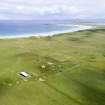North Uist, Dunskellor
Midden (Period Unassigned), Box (Bone)(Period Unassigned), Hammerstone(S) (Period Unassigned), Rivet(S) (Iron)(Period Unassigned), Unidentified Flint(S) (Flint)(Period Unassigned)
Site Name North Uist, Dunskellor
Classification Midden (Period Unassigned), Box (Bone)(Period Unassigned), Hammerstone(S) (Period Unassigned), Rivet(S) (Iron)(Period Unassigned), Unidentified Flint(S) (Flint)(Period Unassigned)
Canmore ID 10340
Site Number NF87NW 8
NGR NF 805 756
NGR Description NF 805 756 and NF 805 757
Datum OSGB36 - NGR
Permalink http://canmore.org.uk/site/10340
- Council Western Isles
- Parish North Uist
- Former Region Western Isles Islands Area
- Former District Western Isles
- Former County Inverness-shire
NF87NW 8 805 756 and 805 757.
(Area: NF 806 756) There is a thin but typical stratum of kitchen-midden material, in which have been found fragments of crude ornamented pottery, in the steep west edge of Skellor burial-ground. The layer shows at intervals for many yards to the north.
Westwards from the graveyard, at the north base of the long natural terrace, were found flints, hammerstones, part of an antler, bone pins and Viking-type iron rivets etc., but to the east nothing of interest was discovered. (E Beveridge 1911)
A spheroidal bone box fitted with a stopper, found here, is in the National Museum of Antiquities of Scotland (NMAS). E Beveridge 1911; Proc Soc Antiq Scot 1922.
There is a considerable scatter of midden material (shell deposits only) in the areas centred at NF 805 757 and NF 805 756.
Visited by OS (R D) 20 June 1965.
Soil Sampling (4 March 2003 - 12 March 2003)
AOC Archaeology were grant aided by Historic Scotland for a second successive season of fieldwork related to a partnership project to assist a PhD studentship investigating the Marine Reservoir Effect, as well as a further project which includes analyses of Plaggan Soils. A total of 25 potential sites were visited to ascertain their potential for sample retrieval relating to the two projects described above.
None of the ecofactual or artefactual material noted at any of the sites visited could be described as being in secure contexts. The material was either within what appeared to be deposits interpreted as topsoil, in unstratified spreads, which were eroding out of the overlying eroding windblown sands, or in the case of Galston within deposits which appeared to have slumped down from above. In light of this no samples were taken for the PhD studentship concerned with the Marine Resevoir Effect. Some soil micromorphological samples were, however, taken in the connection with the study into Plaggan soils. These samples will be reported on at a later date.
AOC Archaeology - Alan Duffy (2003)












